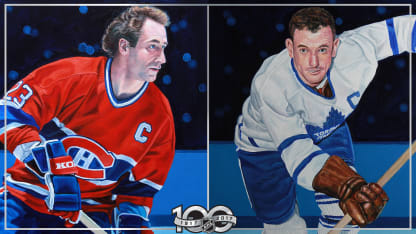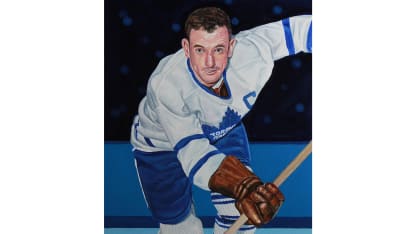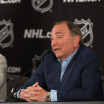As part of the NHL Centennial Celebration, renowned Canadian artist Tony Harris will paint original portraits of each of the 100 Greatest NHL Players presented by Molson Canadian as chosen by a Blue Ribbon panel. NHL.com will reveal two portraits each Monday in 2017.
This week, the portraits of forwards Bob Gainey and Ted Kennedy are unveiled in the 38th installment.
Gainey, Kennedy portraits unveiled
Color paintings of 100 Greatest NHL Players will be revealed on NHL.com every Monday in 2017

By
NHL.com @NHLdotcom
In an era that included many of the highest-scoring players in NHL history, Bob Gainey made his mark by playing defense.
Gainey was a cornerstone of the Montreal Canadiens' four consecutive Stanley Cup-winning teams from 1975-76 through 1978-79. He was their captain in 1985-86, when they recaptured the Cup. Gainey was hardly a prolific scorer; he finished his NHL career with 501 points (239 goals, 262 assists) in 1,160 games. What he did better than any forward of his generation was stop the opposition's top scorers.
Gainey, then 24, was the first winner of the Frank Selke Trophy, given to the NHL's top defensive forward, in 1978. For good measure, he won it in each of the next three seasons as well.
Though the Canadiens' offense, led by superstar scorer Guy Lafleur, got most of the headlines during the dynasty days of the 1970s, Montreal led the League in fewest goals allowed in each of those four championship seasons. Gainey was a big reason why the Canadiens' smothering defense was so effective. He excelled at sealing the middle of the neutral zone and clogging the passing lane, and his forechecking skills could make life a nightmare for opposing defensemen.
In his
NHL100 profile of Gainey
, author Stu Hackel wrote that the Canadiens weren't put off by Gainey's lack of scoring in junior hockey:
"Although Gainey was offensively limited, Canadiens executive Claude Ruel, who'd been watching closely, didn't care. 'We had so many good players coming through the pipeline, but they were all scorers,' Ruel said. 'We lacked size. He was a good player, but he had no stats at all. If a guy didn't score goals in junior, you usually didn't draft him. I'd bet no one else had him ranked in the first round.'
"But Montreal did, selecting him No. 8 in the 1973 NHL Draft, eliciting more than a few 'Bob who?' questions. He'd pour everything into the team. He'd work hard to improve his shot, have three 20-goal seasons in the '80s and occasionally contribute a critical goal. When he won the Conn Smythe in '79, his six goals and 10 assists in 16 games were third-best on the Canadiens, and he shut down the top scorers on the New York Rangers, Bruins and Toronto Maple Leafs.
"Beyond the stats, Gainey dispensed and epitomized toughness. The countless gashes and stitches were nothing: In 1984, as was typical, he played a series against the Islanders with one shoulder separated and the other dislocated. Like his father, he punched the clock every day.
"'No player I ever covered has ever worked harder, hit harder or played through as much pain,'" Red Fisher wrote in the Montreal Gazette. "'No player I have ever known has led better by example.'"
Painting Gainey back some early hockey memories for artist Tony Harris.
"I grew up near Peterborough Ontario, so my first big-time hockey experience was watching hometown boy Bob Gainey playing for the Roger Neilson-coached Peterborough Petes," he said. "They were larger than life and when Gainey graduated from juniors, it marked the first person that my friends and I had met that was playing in the NHL. Painting his portrait for the NHL's 100 Greatest Players brought back many great memories of watching those Peterborough teams in the early '70s."
Ted Kennedy, known to his fans as Teeder, was the catalyst of the NHL's first dynasty, the Toronto Maple Leafs, who won the Stanley Cup five times in seven seasons from 1944-45 through 1950-51 and became the first team to win it three straight times in 1947, '48 and '49.
Though he never led the League in scoring or made the First All-Star Team, Kennedy was a leader by example; today, he'd be known as a "200-foot player." Few players in NHL history could match Kennedy's desire to win. He dominated in the faceoff circle, scored clutch goals of his own or set up his teammates, anticipated plays and was a relentless forechecker. Maple Leafs owner Conn Smythe called him "the greatest competitor in hockey."
Kennedy grew up a Maple Leafs fan; his favorite player was Charlie Conacher. He joined Toronto for two games as a 17-year-old in 1942-43 (he's still the youngest player in team history to dress for the Maple Leafs). By 1946-47, Kennedy was wearing Conacher's famous No. 9 on his back and Toronto was on its way to the first of its three consecutive championships.
Ironically, the only individual honor Kennedy won came in 1955, when he took home the Hart Trophy as MVP -- and then retired. He returned for 30 games in 1956-57 before calling it quits for good and was elected into the Hockey Hall of Fame in 1966.
In his
NHL100 profile of Kennedy
, Hackel wrote about the circumstances that resulted in Kennedy playing for the Maple Leafs:
"His desire made him a standout youth hockey player in the neighboring town of Port Colborne, where he caught the attention of the Montreal Canadiens, who invited the 16-year-old to their training camp in 1942. Although ticketed for the Montreal Royals junior team, he grew homesick. Kennedy packed his bags and returned home, joining the Port Colborne Sailors senior team.
"It was a fortuitous move because the Sailors coach was 'Old Poison,' Nels Stewart, who at the time had the most goals in NHL history (324). Stewart saw Kennedy's potential and tutored him in both shooting and passing. Kennedy improved so much that Stewart tipped off the Leafs about him and, before the season's end, he was in Toronto's lineup for two games as a 17-year-old in 1942-43. He is still the youngest player to dress for the Maple Leafs.
"Toronto had to trade with the Canadiens for his rights, and the deal became a huge footnote in hockey history. Maple Leafs executive Frank Selke swapped promising defenseman Frank Eddolls for Kennedy, and Smythe, overseas serving in World War II, was not consulted. It led to a schism between Selke and Smythe, and Selke eventually left the Maple Leafs to run the Canadiens, transforming them into a dynasty. Ironically, Kennedy became Smythe's favorite player.
"Once in Toronto, Kennedy found a new tutor in [coach Hap] Day, who taught him the importance of winning faceoffs. He'd become the NHL's best faceoff man, not only winning draws but positioning his teammates before the puck drop to maximize his effectiveness."
Working on Kennedy's portrait brought some extra satisfaction for Harris.
"Painting portraits from black-and-white photos has become standard practice during this project, and there is a sense of satisfaction in bringing them to life with color," he said. "This picture is one of the few action shots of Ted Kennedy and although it is clearly a promo picture, I think it is a great representation of that era in the history of the NHL."
Bob Gainey

Ted Kennedy


















